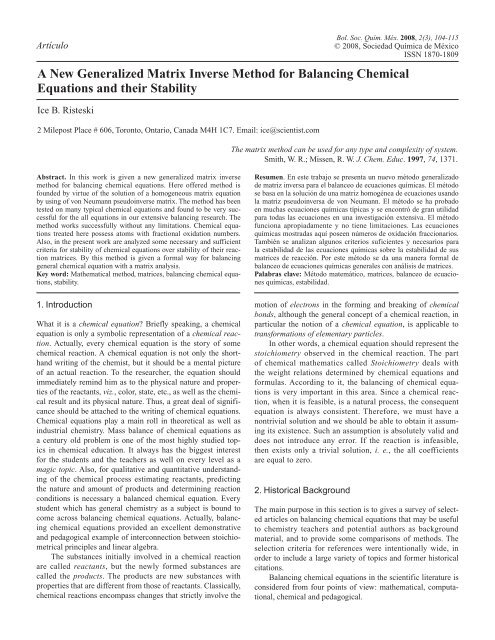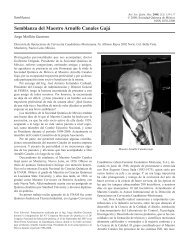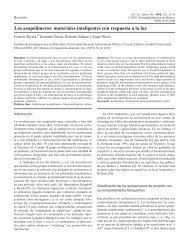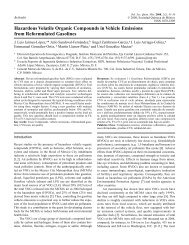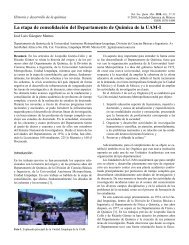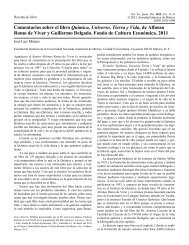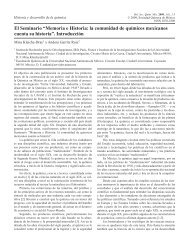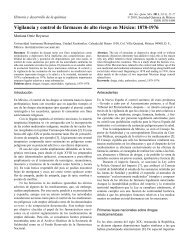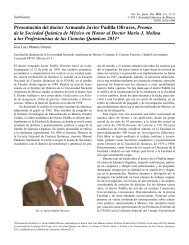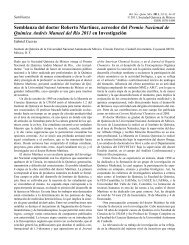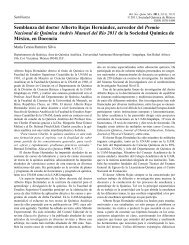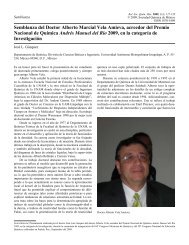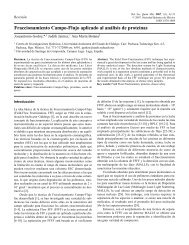A New Generalized Matrix Inverse Method for Balancing Chemical ...
A New Generalized Matrix Inverse Method for Balancing Chemical ...
A New Generalized Matrix Inverse Method for Balancing Chemical ...
Create successful ePaper yourself
Turn your PDF publications into a flip-book with our unique Google optimized e-Paper software.
Artículo<br />
A <strong>New</strong> <strong>Generalized</strong> <strong>Matrix</strong> <strong>Inverse</strong> <strong>Method</strong> <strong>for</strong> <strong>Balancing</strong> <strong>Chemical</strong><br />
Equations and their Stability<br />
Ice B. Risteski<br />
2 Milepost Place # 606, Toronto, Ontario, Canada M4H 1C7. Email: ice@scientist.com<br />
Bol. Soc. Quím. Méx. 2008, 2(3), 104-115<br />
© 2008, Sociedad Química de México<br />
ISSN 1870-1809<br />
The matrix method can be used <strong>for</strong> any type and complexity of system.<br />
Smith, W. R.; Missen, R. W. J. Chem. Educ. 1997, 74, 1371.<br />
Abstract. In this work is given a new generalized matrix inverse<br />
method <strong>for</strong> balancing chemical equations. Here offered method is<br />
founded by virtue of the solution of a homogeneous matrix equation<br />
by using of von Neumann pseudoinverse matrix. The method has been<br />
tested on many typical chemical equations and found to be very successful<br />
<strong>for</strong> the all equations in our extensive balancing research. The<br />
method works successfully without any limitations. <strong>Chemical</strong> equations<br />
treated here possess atoms with fractional oxidation numbers.<br />
Also, in the present work are analyzed some necessary and sufficient<br />
criteria <strong>for</strong> stability of chemical equations over stability of their reaction<br />
matrices. By this method is given a <strong>for</strong>mal way <strong>for</strong> balancing<br />
general chemical equation with a matrix analysis.<br />
Key word: Mathematical method, matrices, balancing chemical equations,<br />
stability.<br />
Resumen. En este trabajo se presenta un nuevo método generalizado<br />
de matriz inversa para el balanceo de ecuaciones químicas. El método<br />
se basa en la solución de una matriz homogénea de ecuaciones usando<br />
la matriz pseudoinversa de von Neumann. El método se ha probado<br />
en muchas ecuaciones químicas típicas y se encontró de gran utilidad<br />
para todas las ecuaciones en una investigación extensiva. El método<br />
funciona apropiadamente y no tiene limitaciones. Las ecuaciones<br />
químicas mostradas aquí poseen números de oxidación fraccionarios.<br />
También se analizan algunos criterios suficientes y necesarios para<br />
la estabilidad de las ecuaciones químicas sobre la estabilidad de sus<br />
matrices de reacción. Por este método se da una manera <strong>for</strong>mal de<br />
balanceo de ecuaciones químicas generales con análisis de matrices.<br />
Palabras clave: Método matemático, matrices, balanceo de ecuaciones<br />
químicas, estabilidad.<br />
1. Introduction<br />
What it is a chemical equation? Briefly speaking, a chemical<br />
equation is only a symbolic representation of a chemical reaction.<br />
Actually, every chemical equation is the story of some<br />
chemical reaction. A chemical equation is not only the shorthand<br />
writing of the chemist, but it should be a mental picture<br />
of an actual reaction. To the researcher, the equation should<br />
immediately remind him as to the physical nature and properties<br />
of the reactants, viz., color, state, etc., as well as the chemical<br />
result and its physical nature. Thus, a great deal of significance<br />
should be attached to the writing of chemical equations.<br />
<strong>Chemical</strong> equations play a main roll in theoretical as well as<br />
industrial chemistry. Mass balance of chemical equations as<br />
a century old problem is one of the most highly studied topics<br />
in chemical education. It always has the biggest interest<br />
<strong>for</strong> the students and the teachers as well on every level as a<br />
magic topic. Also, <strong>for</strong> qualitative and quantitative understanding<br />
of the chemical process estimating reactants, predicting<br />
the nature and amount of products and determining reaction<br />
conditions is necessary a balanced chemical equation. Every<br />
student which has general chemistry as a subject is bound to<br />
come across balancing chemical equations. Actually, balancing<br />
chemical equations provided an excellent demonstrative<br />
and pedagogical example of interconnection between stoichiometrical<br />
principles and linear algebra.<br />
The substances initially involved in a chemical reaction<br />
are called reactants, but the newly <strong>for</strong>med substances are<br />
called the products. The products are new substances with<br />
properties that are different from those of reactants. Classically,<br />
chemical reactions encompass changes that strictly involve the<br />
motion of electrons in the <strong>for</strong>ming and breaking of chemical<br />
bonds, although the general concept of a chemical reaction, in<br />
particular the notion of a chemical equation, is applicable to<br />
trans<strong>for</strong>mations of elementary particles.<br />
In other words, a chemical equation should represent the<br />
stoichiometry observed in the chemical reaction. The part<br />
of chemical mathematics called Stoichiometry deals with<br />
the weight relations determined by chemical equations and<br />
<strong>for</strong>mulas. According to it, the balancing of chemical equations<br />
is very important in this area. Since a chemical reaction,<br />
when it is feasible, is a natural process, the consequent<br />
equation is always consistent. There<strong>for</strong>e, we must have a<br />
nontrivial solution and we should be able to obtain it assuming<br />
its existence. Such an assumption is absolutely valid and<br />
does not introduce any error. If the reaction is infeasible,<br />
then exists only a trivial solution, i. e., the all coefficients<br />
are equal to zero.<br />
2. Historical Background<br />
The main purpose in this section is to gives a survey of selected<br />
articles on balancing chemical equations that may be useful<br />
to chemistry teachers and potential authors as background<br />
material, and to provide some comparisons of methods. The<br />
selection criteria <strong>for</strong> references were intentionally wide, in<br />
order to include a large variety of topics and <strong>for</strong>mer historical<br />
citations.<br />
<strong>Balancing</strong> chemical equations in the scientific literature is<br />
considered from four points of view: mathematical, computational,<br />
chemical and pedagogical.
A <strong>New</strong> <strong>Generalized</strong> <strong>Matrix</strong> <strong>Inverse</strong> <strong>Method</strong> <strong>for</strong> <strong>Balancing</strong> <strong>Chemical</strong> Equations and their Stability 105<br />
Now, shortly we will describe these views.<br />
• Jones <strong>for</strong> the first time in mathematics proposed the<br />
general problem <strong>for</strong> balancing chemical equations<br />
[1]. Actually he <strong>for</strong>malized century old problem in a<br />
compact linear operator <strong>for</strong>m as a Diophantine matrix<br />
equation. This problem was not solved 36 years. After<br />
that, Krishnamurthy [2] gave a mathematical method<br />
<strong>for</strong> balancing chemical equations founded by virtue of<br />
a generalized matrix inverse. He considered some elementary<br />
chemical equations, which were well known in<br />
chemistry since long time. Little bit late Das [3] offered<br />
a simple mathematical method, which was discussed in<br />
[4, 5]. A computer model <strong>for</strong> balancing some elementary<br />
chemical equations over an integer programming<br />
approach is given in [6]. Finally, in [7] by using of a<br />
reflexive g-inverse matrix is solved the general problem<br />
of balancing chemical equations proposed in [1]. Other<br />
mathematical results <strong>for</strong> balancing chemical equations<br />
and their stability over a nonsingular matrix method are<br />
obtained in [8]. The most general results <strong>for</strong> balancing<br />
chemical equations over a Moore-Penrose pseudoinverse<br />
matrix are obtained in [9]. In [10] is balanced a new<br />
class of chemical equations which reduces to a square<br />
n×n matrix. The solution of this class of chemical<br />
equation is founded by virtue of Drazin pseudoinverse<br />
matrix. Actually, to date in mathematics and chemistry<br />
there are only five strictly <strong>for</strong>malized consistent mathematical<br />
methods <strong>for</strong> balancing chemical equations,<br />
particularly they are methods given in [7, 8, 9, 10] and<br />
right now presented method in this work, while other so<br />
called methods in chemical sense have limited usage,<br />
and they are useful only <strong>for</strong> particular cases, especially<br />
<strong>for</strong> balancing chemical equations which possess atoms<br />
with integer oxidation numbers.<br />
• There are many published articles in chemistry [11-31],<br />
which consider the use of computers to balancing chemical<br />
equations. All of these computational methods<br />
use some commercial softer packet, but un<strong>for</strong>tunately<br />
no one of them not deal with fractional oxidation<br />
numbers. Just that, it is one of their biggest weaknesses,<br />
which limit them to be applicable only in some<br />
particular cases and nothing more. It is of interest to<br />
emphasis here that same holds <strong>for</strong> the current online<br />
methods available on internet which employ only integer<br />
oxidation numbers. So, to date we do not know any<br />
computer method <strong>for</strong> balancing chemical equations<br />
to deal with fractional oxidation numbers, except previously<br />
mentioned methods of the author of this work.<br />
Actually, it was the main motive <strong>for</strong> the author to direct<br />
his research <strong>for</strong> development of new mathematical<br />
methods <strong>for</strong> balancing chemical equations in Q (the<br />
set of rational numbers of <strong>for</strong>m p/q) in such a way to<br />
extend and generalize the current particular techniques<br />
used in chemistry right now <strong>for</strong> balancing only chemical<br />
equations in N (the set of natural numbers).<br />
• University textbooks of general chemistry generally<br />
support the ion-electron technique as basic procedure<br />
<strong>for</strong> balancing chemical equation, because it makes the<br />
best use of fundamental chemical principles. Also,<br />
some authors advocated other techniques which involve<br />
less algebraic manipulation that may deserve attention<br />
– particularly in classes of chemistry and chemical<br />
engineering majors [32-58].<br />
Several simple chemical equations are solved by elementary<br />
algebraic techniques in [47, 59-64]. The earliest<br />
article that makes use of the linear algebra method<br />
was published by Bottomley [65]. A set of various<br />
modifications which implement this approach is documented<br />
in [33, 46, 47, 66-68]. The case when the<br />
chemical equation has no unique solution received<br />
considerable attention in the education articles [20,<br />
69-79]. The equation represents two or more independently<br />
occurring reactions can be combined in varying<br />
stoichiometric ratios [80, 81]. Fixed ratios of reagents,<br />
observed experimentally in particular cases, are equivalent<br />
to a restriction on the coefficients that make a<br />
unique solution [20].<br />
It is necessary to emphasis that balancing chemical<br />
equations by inspection is equivalent to using the<br />
algebraic method or a computerized matrix algebra<br />
approach [82, 83]. The valence change method [32,<br />
84-106] and the ion-electron method [83-88, 92, 101,<br />
107-113] are also simple algebraic inspection techniques,<br />
subjected to exactly the same controls and<br />
limitations as the algebraic and matrix methods. Here<br />
it is good to emphasis that first Karslake in [114]<br />
considered balancing of ionic chemical equations.<br />
Actually, the technique suggested by García [115]<br />
can reduces the number of algebraic steps <strong>for</strong> ionelectron<br />
method. Previous both mentioned methods<br />
- the valence change method and ion-electron method<br />
begin by establishing the relative proportions of reagents<br />
taking part in separate oxidation and reduction<br />
components of a redox reaction. Then, each technique<br />
uses a lowest common multiplier to en<strong>for</strong>ce a principle<br />
of conservancy - <strong>for</strong> instance, conservation of<br />
oxidation number change in the case of the oxidation<br />
number method. Johnson in his article [116] defined<br />
the equivalent term oxidation stage change on this<br />
subject.<br />
Stout in [117] presented three redox reactions as<br />
puzzles. Each one can be shown as simple redox system,<br />
which may easily be balanced using here offered<br />
method. After this article was published, the followed<br />
other debatable articles with critical accent [118-123].<br />
• <strong>Balancing</strong> chemical equations through the pedagogical<br />
point of view is given in the articles [112, 124-131].<br />
This approach is very interesting <strong>for</strong> the education of<br />
chemical research. A check of the hypothesis that <strong>for</strong>mal<br />
reasoning and a sufficiently large mental capacity<br />
are required to balance more complex many-step equa-
106 Bol. Soc. Quím. Méx. 2008, 2(3) Ice B. Risteski<br />
tions is made over a test to determine level of intellectual<br />
development, mental capacity, and degree of field<br />
dependence/field independence of the students [131].<br />
3. Preliminaries<br />
Now we will introduce some well known results from the<br />
matrix algebra. Throughout, the set of n×n matrices over a<br />
field will be denoted by n×n .<br />
Let A∈ n×n and rank A = r < n. If the matrix A has an<br />
invertible matrix of its eigenvectors, then A has an eigen<br />
decomposition. Singular value decomposition of matrix A is<br />
a factorization of the <strong>for</strong>m A = USV T , where U and V are n ×<br />
n regular matrices, S = diag(d 1 ,…, d r , 0, … , 0) and T denotes<br />
transpose.<br />
The matrix<br />
A N = (V T ) -1 diag(1/d 1 ,…, 1/d r , 0,… , 0)U -1<br />
satisfies the equality AA N A = A. This means that the matrix<br />
equation AA N A = A has at least one solution <strong>for</strong> A N .<br />
If A satisfies the identity<br />
A r + k 1 A r-1 + ··· + k r-1 A = O (k r-1 ≠ 0),<br />
where O is the n × n zero matrix, then the matrix<br />
A N = - (A r-2 + k 1 A r-3 + ··· + k r-2 I)/k r-1 ,<br />
where I is the unit n × n matrix, is also a solution of the equation<br />
AA N A = A.<br />
Definition 3.1. The von Neumann pseudoinverse A N of a<br />
matrix A∈ n×n is the matrix which satisfies the condition<br />
AA N A = A. (3. 1)<br />
Von Neumann considered relation (3. 1) on rings of operators<br />
in [132-135].<br />
Remark 3.2. If A is nonsingular, then it is easily seen that A -1<br />
satisfies (3.1), i. e., A N = A -1 .<br />
Definition 3.3. The characteristic equation of an n × n matrix<br />
A is the equation in one variable λ<br />
det(A - λI) = 0, (3. 2)<br />
where det(·) denotes a determinant and I is an n×n identity<br />
matrix.<br />
Definition 3. 4. The polynomial<br />
p(l) = det(A - lI) = l n + a 1 l n-1 + ··· + a n-1 l + a n , (3. 3)<br />
which results from evaluating the determinant (3. 2) is the<br />
characteristic polynomial of the matrix A.<br />
Definition 3.5. The roots of the characteristic polynomial (3.3)<br />
are precisely the eigenvalues of the matrix A.<br />
Let s(A) = {l i , 1 ≤ i ≤ n} be the spectrum of A.<br />
The polynomial (3.3) of degree n ≥ 1 with real coefficients<br />
a v (1 ≤ v ≤ n), by the fundamental theorem of algebra<br />
has n (not necessarily distinct) roots l 1 , l 2 ,…, l n .<br />
Definition 3.6. For any matrix A∈ n×n we denote ImA =<br />
{y∈ n : y = Ax <strong>for</strong> some x∈ n } the image of A or range of A.<br />
Definition 3.7. For any matrix A∈ n×n we denote KerA =<br />
{x∈ n : Ax = 0} the kernel of A or null space of A.<br />
Definition 3.8. nullityA = dim(KerA).<br />
Definition 3.9. rankA = dim(ImA).<br />
Let rankA = r and let nullityA = k. According to [136], the<br />
deterministic approach is important, since it enables us to classify<br />
the chemical reaction as:<br />
1º infeasible when the nullity of the reaction matrix is<br />
zero;<br />
2º unique (within relative proportions) when the nullity<br />
of the reaction matrix is one;<br />
3º non-unique when its nullity is bigger than one.<br />
Possible cases of balancing chemical equations are the following:<br />
1. If r = n then k = n - r = 0, i. e., trivial solution x = 0,<br />
the reaction is infeasible.<br />
2. If r = n - 1, then k = n - r = 1, unique solution x ≠ 0, i.<br />
e., the reaction is feasible and is unique.<br />
In practical terms this means that the general procedure<br />
<strong>for</strong> obtaining these coefficients is to solve the<br />
system of linear equations derived from the principles<br />
of conservation of matter and charge, applied to the<br />
reaction element-by-element.<br />
3. If r < n - 1, then k = n - r > 1, k (>1) linearly independent<br />
solutions x ≠ 0, i. e., the reaction is feasible and<br />
is non-unique.<br />
Last kind of the reactions are puzzling in that they exhibit<br />
infinite linearly independent solution all of which satisfy the<br />
chemical balance, and yet they are not all chemically feasible<br />
solutions <strong>for</strong> a given set of experimental conditions. A unique<br />
solution is obtained by imposing a chemical constraint, namely,<br />
that reactants have to react only in certain proportions.<br />
Let | · | denotes a vector norm in n .<br />
Definition 3. 10. The Lozinskiĭ measure m on n with respect<br />
to | · | is defined by<br />
( )<br />
µ ( A) = li m I + ρA<br />
−1 / ρ.<br />
ρ→ 0 +<br />
(3.4)<br />
Definition 3.11. The Lozinskiĭ measures of A = [a ij ] n×n with<br />
respect to the three common norms<br />
|x| ∞ = sup i |x i |,<br />
|x| 1 = S i |x i |, (3.5)<br />
|x| 2 = (S i |x i | 2 ) 1/2 ,
A <strong>New</strong> <strong>Generalized</strong> <strong>Matrix</strong> <strong>Inverse</strong> <strong>Method</strong> <strong>for</strong> <strong>Balancing</strong> <strong>Chemical</strong> Equations and their Stability 107<br />
are<br />
where<br />
m ∞ (A) = sup i (a ii + S k,k≠i |a ik |),<br />
m 1 (A) = sup k (a kk + S i,i≠k |a ik |), (3.6)<br />
m 2 (A) = stab[(A + A T )/2],<br />
stab(A) = max{l, l∈s(A)}<br />
(0, 0,…, 0) is a null column vector of order n, and T denotes<br />
transpose.<br />
Proof. If we develop the molecules of the reaction (4. 1) in<br />
an explicit <strong>for</strong>m, then we obtain the reaction matrix A shown<br />
below<br />
is the stability modulus of A.<br />
Definition 3. 12. The matrix A is stable if stab(A) < 0.<br />
4. Main Results<br />
In this section we will give a completely new method <strong>for</strong><br />
balancing chemical equations. Given analysis is done <strong>for</strong> arbitrary<br />
chemical equation presented in its general <strong>for</strong>m.<br />
Proposition 4. 1. Any chemical equation may be presented in<br />
this <strong>for</strong>m<br />
n n<br />
∑ x i<br />
j ∏ aij = 0<br />
j= 1 i=<br />
1<br />
Ψ ,<br />
(4. 1)<br />
where x j (1 ≤ j ≤ n) are unknown rational coefficients, Ψ i (1 ≤<br />
i ≤ n) are chemical elements and a ij (1 ≤ i, j ≤ n) are numbers<br />
of atoms of element Ψ i in j-th molecule.<br />
Proof. Let there exists an arbitrary chemical equation<br />
from n distinct elements and n molecules<br />
n<br />
∑ x j j = 0<br />
j=<br />
1<br />
Φ , (4. 2)<br />
where Φ j = Ψ 1 a1jΨ 2 a2j···Ψ n anj (1 ≤ j ≤ n). Then previous expression<br />
becomes<br />
n<br />
1 2<br />
∑ x j Ψa j a j a n<br />
1<br />
Ψ<br />
2<br />
Ψ<br />
n j = 0<br />
j=<br />
1<br />
... , (4. 3)<br />
If we write the above equation in a compact <strong>for</strong>m, then<br />
immediately follows (4. 1).<br />
<br />
The coefficients satisfy three basic principles (corresponding<br />
to a closed input-output static model [137, 138])<br />
• the low of conversation of atoms,<br />
• the low of conversation of mass, and<br />
• the time-independence of the reaction.<br />
Theorem 4. 2. The chemical equation (4.1) can be reduced to<br />
the following matrix equation<br />
Ax = 0, (4. 4)<br />
where A = [a ij ] n×n is a reaction matrix, x T = (x 1 , x 2 , … , x n )<br />
is a column vector of the coefficients x j (1 ≤ j ≤ n) and 0 T =<br />
or<br />
i.e.,<br />
From the above development we obtain that<br />
n<br />
i<br />
Φ j = ∑aijΨ<br />
1 ≤ j ≤ n<br />
i=<br />
1<br />
If we substitute (4. 5) into (4. 2), follows<br />
n n<br />
i<br />
∑ x j∑aijΨ = 0<br />
j=<br />
1 i=<br />
1<br />
n n<br />
∑Ψ i ∑aij x j = 0<br />
i=<br />
1 j=<br />
1<br />
n<br />
∑aij<br />
x j = 0 ( 1 ≤ i ≤ m)<br />
.<br />
j=<br />
1<br />
( ). (4.5)<br />
. (4.6)<br />
.<br />
(4. 7)<br />
(4. 8)<br />
Last equation if we present in a matrix <strong>for</strong>m, actually we<br />
obtain (4. 4).<br />
<br />
Now we will prove the following result.<br />
Theorem 4. 3. If A N satisfies the condition AA N A = A, then<br />
1° AX = O ⇒ X = (I - A N A)Q, (X and Q are n×m<br />
matrices),<br />
2° XA = O ⇒ X = Q(I - AA N ), (X and Q are m×n<br />
matrices),<br />
3° AXA = A ⇒ X = A N + Q - A N AQAA N (X and Q are<br />
n×n matrices),<br />
4° AX = A ⇒ X = I + (I - A N A)Q (X and Q are n×n<br />
matrices),<br />
5° XA = A ⇒ X = I + Q(I - AA N ) (X and Q are n×n<br />
matrices), where Q is an arbitrary matrix.<br />
Proof. We will prove the theorem completely <strong>for</strong> every case.<br />
1° Let X = (I - A N A)Q. Further it follows that<br />
AX = AQ - AA N AQ, AA N A = A<br />
⇒ AX = AQ - AQ ⇒ AX = O.<br />
Conversely, assume that AX = O, then it holds that<br />
Thus<br />
(I - A N A)(X - A N ) = X - A N AX - A N + A N AA N<br />
= X - A N AX = X.<br />
AX = O ⇒ X = (I - A N A)Q, <strong>for</strong> Q = X - A N .
108 Bol. Soc. Quím. Méx. 2008, 2(3) Ice B. Risteski<br />
2° Now, similarly as in the previous case we will prove<br />
this part of the theorem.<br />
Assume X = Q(I - AA N ), then it holds that<br />
XA = QA - QAA N A, AA N A = A<br />
⇒ XA = QA - QA ⇒ XA = O.<br />
Remark 4. 4. Also, the above theorem <strong>for</strong> A N = B was<br />
employed <strong>for</strong> solving of lot of cyclic linear complex vector<br />
functional equations [139-141].<br />
If X is an n×1 matrix, according to Theorem 4.3 the solution<br />
of the homogeneous system of equations<br />
Conversely, assume that XA = O, then it holds that<br />
Thus<br />
(X - A N )(I - AA N ) = X - A N - XAA N + A N AA N<br />
= X - XAA N = X.<br />
x 1<br />
x 2<br />
.<br />
.<br />
.<br />
x n<br />
= 0<br />
XA = O ⇒ X = Q(I - AA N ), <strong>for</strong> Q = X - A N .<br />
3° Let X = A N + Q - A N AQAA N . Further it holds that<br />
AXA = A A N A + AQA - AA N AQAA N A, A A N A = A<br />
⇒ AXA = A + AQA - AQA ⇒ AXA = A.<br />
obtains this <strong>for</strong>m<br />
x 1<br />
x 2<br />
q 1<br />
q 2<br />
Conversely, assume that AXA = A, then it holds that<br />
B + (X - A N ) - A N A(X - A N )AA N = X - A N AXAA N<br />
+ A N AA N AA N = X - A N AA N + A N AA N = X.<br />
.<br />
. ,<br />
.<br />
.<br />
.<br />
.<br />
x n<br />
q n<br />
(4. 9)<br />
Thus<br />
AXA = A ⇒ X = A N + Q - A N AQAA N , <strong>for</strong> Q = X - A N .<br />
4° Assume X = I + (I - A N A)Q. After multiplication by<br />
A, on obtains<br />
AX = A + AQ - AA N AQ, AA N A = A<br />
⇒ AX = A + AQ - AQ ⇒ AX = A.<br />
Conversely, assume that AX = A, then it holds that<br />
Thus<br />
I + (I - A N A)(X - A N A - I)<br />
= I + X - A N AX - A N A + A N AA N A - I + A N A<br />
= I + X - A N A - A N A + A N A - I + A N A = X.<br />
AX = A ⇒ X = I + (I - A N A)Q, <strong>for</strong> Q = X - A N A - I.<br />
5° Assume that X = I + Q(I - AA N ), then it holds that<br />
XA = A + QA - QAA N A, AA N A = A,<br />
⇒ XA = A + QA - QA ⇒ AX = A.<br />
Conversely, assume that XA = A, then it holds that<br />
where q 1 , ... , q n are arbitrary.<br />
Definition 4.5. <strong>Chemical</strong> equation (4.1) is stable if stab(A) < 0.<br />
Lemma 4.6. For any nonsingular matrix U and any vector<br />
norm | · |, with the induced Lozinskiĭ measure m, |Ux| defines<br />
another vector norm and its induced matrix measure m U is<br />
given by<br />
m U (A) = m(UAU -1 ). (4. 10)<br />
Proof. The proof of this lemma follows directly from the<br />
Definition 3. 10.<br />
<br />
Theorem 4.7. For any matrix A∈ n×n it holds<br />
stab(A) = inf{m(A), m is a Lozinskiĭ measure on n }. (4.11)<br />
Proof. The relation (4.11) obviously holds <strong>for</strong> diagonalizable<br />
matrices in view of (4.10) and the first two relations in (3.6).<br />
Furthermore, the infimum in (4.11) can be achieved if the<br />
matrix A is diagonalizable. The general case can be shown<br />
based on this observation, the fact that A can be approximated<br />
by diagonalizable matrices in R and the continuity of m(·),<br />
which is implied by the property<br />
Thus<br />
I + (X - AA N - I)(I - AA N )<br />
= I + X - AA N - I - XAA N + AA N AA N + AA N<br />
= I + X - AA N - I - AA N + AA N + AA N = X.<br />
|m(Á) - m(À)| ≤ |Á - À|.<br />
Remark 4.8. From the above proof it follows that<br />
stab(A) = inf{m ∞ (UAU -1 ), detU ≠ 0}.<br />
<br />
XA = A ⇒ X = I + Q(I - AA N ), <strong>for</strong> Q = X - AA N - I.<br />
<br />
The same relation holds if m ∞ is replaced by m 1 .
A <strong>New</strong> <strong>Generalized</strong> <strong>Matrix</strong> <strong>Inverse</strong> <strong>Method</strong> <strong>for</strong> <strong>Balancing</strong> <strong>Chemical</strong> Equations and their Stability 109<br />
Corollary 4.9. Let A∈. Then stab(A) < 0 ⇔ m(A) < 0 <strong>for</strong><br />
some Lozinskiĭ measure m on n .<br />
More results <strong>for</strong> stability criteria are obtained in works<br />
[142, 143].<br />
5. An Application of the Main Results<br />
In this section will be applied above method on many chemical<br />
equations <strong>for</strong> their balancing. All chemical equations balanced<br />
here appear first time in professional literature and they are<br />
chosen with an intention to be avoided to date all well known<br />
chemical equations which were repeated many times in the<br />
chemical journals <strong>for</strong> explanation of certain particular techniques<br />
<strong>for</strong> balancing of some chemical equations using only<br />
atoms with integer oxidation numbers.<br />
1º First we will consider an infeasible reaction, i. e., the<br />
case when the nullity of the reaction matrix is zero.<br />
matrix is one. Here we will balance many special chemical<br />
equations with a goal to show the power of the offered mathematical<br />
method.<br />
Example 5. 2. Consider this equation<br />
x 1 [4Yb(CN) 3·3Yb(CN) 2 ] + x 2 CsRu(CN) 2 F 2 (5. 2)<br />
+ x 3 CsRu(CN) 4 + x 4 CsHF 2 + x 5 [PtF 3·7H 2 O]<br />
= x 6 [Pt(NH 3 ) 2 (C 5 H 4 ON)] 2 (NO 3 ) 2·2H 2 O<br />
+ x 7 Cs 3.99 Yb(CN) 6 + x 8 HRuF 2.97 + x 9 NO 2 .<br />
From the scheme given below<br />
Example 5. 1. Consider chemical equation<br />
x 1 Fe 2 (SO 4 ) 3 + x 2 PrTlTe 3 + x 3 H 3 PO 4 (5. 1)<br />
= x 4 Fe(H 2 PO 4 ) 2·H 2 O + x 5 Pr 2 (SO 4 ) 3 + x 6 Tl 1.99 (SO 3 ) 3<br />
+ x 7 Te 2 O 3 + x 8 H 2 O.<br />
The reaction matrix<br />
2 0 0 -1 0.00 0.00 0 0<br />
3 0 0 0 -3.00 -3.00 0 0<br />
12 0 4 -9 -12.0 -9.00 -3 -1<br />
0 1 0 0 -2.00 0.00 0 0<br />
0 1 0 0 0.00 -1.99 0 0 .<br />
0 3 0 0 0.00 0.00 -2 0<br />
0 0 3 -6 0.00 0.00 0 -2<br />
0 0 1 -2 0.00 0.00 0 0<br />
is obtained from this scheme<br />
is derived the reaction matrix<br />
⎡ 7.00 0 0 0 0.00 0.00 -1.00 0.00 0 ⎤.<br />
⎢ 18.0 2 4 0 0.00 -10.0 -6.00 0.00 0 ⎥.<br />
⎢ 18.0 2 4 0 0.00 -8.00 -6.00 0.00 -1 ⎥.<br />
⎢ 0.00 1 1 1 0.00 0.00 -3.99 0.00 0 ⎥.<br />
A = ⎢ 0.00 1 1 0 0.00 0.00 0.00 -1.00 0 ⎥.<br />
⎢ 0.00 2 0 2 3.00 0.00 0.00 -2.97 0 ⎥.<br />
⎢ 0.00 0 0 1 14.0 -24.0 0.00 -1.00 0 ⎥.<br />
⎢ 0.00 0 0 0 1.00 -2.00 0.00 0.00 0 ⎥.<br />
⎣ 0.00 0 0 0 7.00 -10.0 0.00 0.00 -2 ⎦.<br />
The rank of the above matrix is r = 8. Since the nullity of<br />
the reaction matrix is k = n - r = 8 - 8 = 0, then we have only a<br />
trivial solution x = 0, that means that the reaction is infeasible.<br />
2º Next, we will consider the case when the chemical reaction<br />
is feasible and is unique, i. e., the nullity of its reaction<br />
The rank of the above matrix is r = 8. Since the nullity of<br />
the reaction matrix is k = n - r = 9 - 8 = 1, then we have a nontrivial<br />
solution x ≠ 0, that means that the reaction is feasible.<br />
Singular value decomposition of the matrix A is given by<br />
the expression A = USV T , where
110 Bol. Soc. Quím. Méx. 2008, 2(3) Ice B. Risteski<br />
⎡ -0.108818459557726 -0.525441407603166<br />
⎢ 0.214701170957876 0.450899256172441<br />
⎢ 0.016066764162855 0.057213059874600<br />
⎢ -0.484373182392954 0.098454545415393<br />
U = ⎢ 0.345438356921560 -0.304312644967055<br />
⎢ 0.547145909762408 0.015307612109590<br />
⎢ -0.523852079829627 0.148809263996733<br />
⎢ -0.118613333029776 -0.568932626114908<br />
⎣ 0.000000000000000 0.262612865719445<br />
-0.483709300771011 -0.025011484625246<br />
0.483572372868432 0.046136078870445<br />
-0.046373294704348 -0.453189307512911<br />
-0.004184833431819 0.765218064375209<br />
0.180768863041104 0.278205209655966<br />
-0.216740730980893 0.303122641025548<br />
0.054658267642886 -0.187510779304511<br />
0.615148849855887 -0.043184335536401<br />
-0.262612865719445 0.000000000000000<br />
-0.005419903080133 -0.031804241854372<br />
0.007672804708575 -0.054870209881318<br />
-0.215770782653738 -0.859989638320084<br />
0.006660853893509 -0.406023012474453<br />
-0.310494489641576 -0.099401772162723<br />
-0.531515502920401 0.004639387101885<br />
-0.755862036723293 0.282361389851866<br />
-0.055383920003139 -0.043711496085823<br />
0.000000000000000 0.000000000000000<br />
-0.631375254382829 -0.051094299859864<br />
-0.651011866763206 -0.051017560379749<br />
0.042288273104927 0.030745308960465<br />
0.021835681349140 0.019913511012403<br />
-0.253995146388407 -0.036993147062515<br />
0.252752992636479 0.000040477189790<br />
-0.101377108856827 0.034418504872053<br />
0.191334300606536 -0.382183260829536<br />
0.000000000000000 -0.919145030018058<br />
-0.274195885354736 ⎤<br />
-0.291776689266259 ⎥<br />
0.008044453565360 ⎥<br />
-0.065884180607602 ⎥<br />
0.711210986578713 ⎥,<br />
-0.463813345852432 ⎥<br />
0.052627541396678 ⎥<br />
-0.307119873865167 ⎥<br />
0.131306432859722 ⎦<br />
S = diag(35.7077953660721, 25.0075595691818,<br />
5.14897940671986, 4.2433996813797,<br />
2.45040387879316, 1.90114742807227,<br />
0.398185956988948, 0.143150036571975, 0)<br />
and<br />
⎡-0.530036698530604 0.732714340587708<br />
⎢-0.059156306529345 0.072498546564787<br />
⎢-0.113897656786349 0.151621968119400<br />
⎢-0.020163530549436 -0.028576007414021<br />
V T = ⎢-0.305399190077898 -0.454751736894276<br />
⎢ 0.759532806845423 0.410536471688309<br />
⎢ 0.175410396224260 -0.240151938188209<br />
⎢ 0.020478826773642 0.032242393871809<br />
⎣ 0.028904082733182 0.003998031290798<br />
0.059736716329278 -0.399151055338640<br />
-0.459753215050118 0.034965435364956<br />
-0.121500006131151 0.270763503905774<br />
-0.413845180321981 -0.005889683061020<br />
-0.369175414664211 -0.319000177550112<br />
-0.263741188677449 -0.201750581917647<br />
0.335429576497838 -0.738668379535351<br />
0.529746095274656 0.277464273981295<br />
0.005881629189292 0.032038743661973<br />
0.079285062134118 0.107422089227711<br />
-0.195143499527296 -0.327160490685546<br />
-0.214848014339865 -0.543947997988063<br />
-0.071250899726732 0.297270164070787<br />
0.443741704162715 0.160853971619241<br />
0.267194927606734 0.080388509256987<br />
-0.291468054745698 -0.288250414531082<br />
0.350845387894457 0.139380842684048<br />
-0.654255753540559 0.601935129168877<br />
-0.011424283590129 0.011167975695062<br />
0.071034717469835 -0.653571612482181<br />
-0.325231684333164 0.602840498618986<br />
0.692728828581090 0.424219052629831<br />
-0.425389335857176 0.108441064494780<br />
-0.219547150578892 0.081575306129862<br />
0.128620556596709 0.095155332826569<br />
0.046776681580951 -0.042802903689246<br />
-0.401604696573164 -0.006350694329692<br />
0.034926906301773 ⎤<br />
0.448700496904865 ⎥<br />
0.254423990564171 ⎥<br />
0.272384005539498 ⎥<br />
0.215370240964770 ⎥.<br />
0.107685120482385 ⎥<br />
0.244488344112414 ⎥<br />
0.703124487469035 ⎥<br />
0.215370240964769 ⎦<br />
In linear algebra, the singular value decomposition is an<br />
important factorization of rectangular real and complex matrices,<br />
with several applications in applied sciences. Actually, the<br />
singular value decomposition can be seen as a generalization
A <strong>New</strong> <strong>Generalized</strong> <strong>Matrix</strong> <strong>Inverse</strong> <strong>Method</strong> <strong>for</strong> <strong>Balancing</strong> <strong>Chemical</strong> Equations and their Stability 111<br />
of the spectral theorem to arbitrary, not necessarily square<br />
matrices. Since, the matrix A has a matrix of eigenvectors<br />
that is not invertible, i. e., the matrix A does not have an eigen<br />
decomposition, then A can be presented by its singular value<br />
decomposition. The von Neumann pseudoinverse A N of the<br />
matrix A determined by the <strong>for</strong>mula A N = (V T ) -1 diag(1/d 1 ,…,<br />
1/d 8 , 0)U -1 is<br />
⎡ 0.101523256567670 0.321803887120054<br />
⎢ -0.045223147018723 2.643569604152050<br />
⎢ 0.061229664532195 -2.769586211377240<br />
⎢ -0.047374220591932 0.136340300180892<br />
A N = ⎢ -0.025538092341311 0.253565957729192<br />
⎢ 0.012613778846674 0.330397410308811<br />
⎢ 0.012633132259008 -0.919353959433015<br />
⎢ -0.034251335322107 1.751346157688120<br />
⎣ -0.026853724152914 1.433111472758320<br />
-0.288108429146632 -1.188150902038370<br />
-2.485818145278540 -1.420833955106290<br />
2.597366632008940 1.882364109752350<br />
-0.079944559167976 -0.379557722145593<br />
0.569019045271805 -1.535863922093850<br />
-0.413165815277642 0.435071248156406<br />
0.836975164068040 0.435222179359037<br />
-1.633950741785980 -1.074035211448490<br />
-1.271285637926960 -0.911850350422177<br />
0.610923180005891 0.305461590002947<br />
-0.658983155079063 -0.450181232711944<br />
0.420984017508641 0.331181663926733<br />
0.217976731579250 0.108988365789626<br />
0.679224462547416 0.339612231273709<br />
-0.258919826562618 -0.129459913281308<br />
0.241199512637992 0.120599756318995<br />
-0.335319169083302 -0.245245791438202<br />
-0.187299838407709 -0.153994746790060<br />
-0.289337204026299 0.033695457973420<br />
-0.316562029131021 0.157751458873511<br />
0.428607651725322 -0.172219579368304<br />
-0.331619544143528 0.056395741012914<br />
-0.178766646389184 -0.177414996999005<br />
0.088296451926710 -0.082768404968829<br />
0.088431925813047 -0.082378795364977<br />
-0.239759347254723 0.117395415902143<br />
-0.187976069070377 0.161825834831369<br />
0.610923180005892 ⎤<br />
-0.038293499906653 ⎥<br />
-0.199705637663771 ⎥<br />
0.217976731579252 ⎥<br />
0.679224462547419 ⎥.<br />
-0.258919826562618 ⎥<br />
0.241199512637993 ⎥<br />
-0.007732962186752 ⎥<br />
-0.376955010821503 ⎦<br />
Required coefficients of the chemical equation (5. 2),<br />
according to the <strong>for</strong>mula (4. 9) are<br />
⎡x 1 ⎤ ⎡1⎤ ⎡0.087194107660614⎤.<br />
x 2 1 1.120169049513394 .<br />
x 3 1 0.635162835008073 .<br />
x 4 1 0.679999542439780 .<br />
x 5 = (I - A N A) 1 = 0.537666171040854 .<br />
x 6 1 0.268833085520413 .<br />
x 7 1 0.610358753624375 .<br />
x 8 1 1.755331884521518 .<br />
⎣x 9⎦ ⎣1⎦ ⎣0.537666171040864⎦.<br />
Now balanced chemical equation (5. 2) obtains this <strong>for</strong>m<br />
0.087194107660614[4Yb(CN) 3·3Yb(CN) 2 ]<br />
+ 1.120169049513394CsRu(CN) 2 F 2<br />
+ 0.635162835008073CsRu(CN) 4<br />
+ 0.67999954243978CsHF 2<br />
+ 0.537666171040854[PtF 3·7H 2 O]<br />
= 0.268833085520413[Pt(NH 3 ) 2 (C 5 H 4 ON)] 2 (NO 3 ) 2·2H 2 O<br />
+ 0.610358753624375Cs 3.99 Yb(CN) 6<br />
+ 1.755331884521518HRuF 2.97<br />
+ 0.537666171040864NO 2 .<br />
If we multiply above equality by 454159.1291252759 we<br />
obtain the equality in its conventional <strong>for</strong>m<br />
39600[4Yb(CN) 3·3Yb(CN) 2 ] + 508735CsRu(CN) 2 F 2<br />
+ 288465CsRu(CN) 4 + 308828CsHF 2<br />
+ 244186[PtF 3·7H 2 O]<br />
= 122093[Pt(NH 3 ) 2 (C 5 H 4 ON)] 2 (NO 3 ) 2·2H 2 O<br />
+ 277200Cs 3.99 Yb(CN) 6 + 797200HRuF 2.97 + 244186NO 2 .<br />
The eigenvalues of the matrix (A + A T )/2 are<br />
λ 1 = -18.060777308031500, λ 2 = 20.041652979700600,<br />
λ 3 = 14.665879176680500, λ 4 = -5.617846328393410,<br />
λ 5 = 2.319213465566350, λ 6 = -1.937661578812980,<br />
λ 7 = 1.071305345298540, λ 8 = -0.696805962104278,<br />
λ 9 = 0.215040210096249.<br />
The Lozinskii measures of A given by (3. 12) with respect<br />
to the three common norms (3. 11) are<br />
µ ∞ (A) = max (8, 40, 39, 6.99, 3, 9.97, 40, 3, 15) = 40,<br />
µ 1 (A) = max (43, 8, 10, 4, 25, 54, 16.99, 4.97, -1) = 54,<br />
µ 2 (A) = λ 2 = 20.041652979700600.<br />
Since µ 2 (A) > 0 and definition 4. 5 immediately follows<br />
that the chemical equation (5. 2) is unstable.<br />
With this method we balanced successfully lot of chemical<br />
equations and some of them are given below as examples.<br />
The research shown that considered chemical equations are<br />
unstable too.
112 Bol. Soc. Quím. Méx. 2008, 2(3) Ice B. Risteski<br />
+ 16464TiFeCl 6 + 50400GeO 2 + 7572Os 2 O 3<br />
Example 5.3.<br />
+ 1848Sb 2 N 2 PS 7 + 57888Au 2 O + 57888MnO 2 ance this chemical equation<br />
171400AuO·[Pt(C 10 H 8 N 2 ) 3 ]F 2·6H 2 O (5.3)<br />
+ 924Y 2 O 3·HgS + 76776Sr(CeI 4 ) 2<br />
= 924C 69 H 39 Cl 6 CuN 27 O 19 S 7 + 57888C 44 H 34 Au 2 MnO 3 P 2<br />
+ 5592972W 4 Fe(CN) 6 + 1198494C 4 H 3 OsNa 2 OS 7<br />
+ 16800C 44 H 44 O 3 Ge 3 Ti 0.98 + 16464C 44 H 34 FeBr 3 ClO 5<br />
+ 2460568H 2 CO 3 + 10672397Os 2 O + 10157544NO 2<br />
+ 1198086TeO 3 = 171400AuPtOsTe 6.99<br />
+ 2796486Fe 2 (SO 4 ) 3 + 22371888WOs(CN) 2<br />
+ 1210600Na 1.98 CO 3 + 342800HF + 7172109H 2 O.<br />
Example 5.4.<br />
+ 7572(C 22 H 16 O 4 OsPPt) 2 + 462Sb 8 Co 2 Y 4 N 2 O 23<br />
+ 76776SrClF + 76776(CeI 4 ) 2 + 924HgF 2 + 2904CsLiO 2<br />
+ 1452Ga 2 O + 2904HfO 2 + 4400Te 1.98 O 3<br />
+ 91752HNO 3 + 47352H 2 O + 7392SO 2 .<br />
Example 5.9.<br />
153936AgAuPtSe 6·[(NH 3 )HClO 3 ] (5.4)<br />
74744(NH 3 ) 3 [(PO) 4·12MoO 3 ] (5.9)<br />
+ 132534C 4 H 3 AuCs 2 OS 7 + 618492Li 4 Mn(CN) 6<br />
+ 530808HoHgTlZrS 6 + 2121414In 3 SrBkCl 12<br />
+ 70004Ru 3 (CO) 12 + 1093749Au 2 O 3 + 1390920HNO 3<br />
= 153936Pt(NH 3 )·ClNO 3 + 133200Cs 1.99 CO 3<br />
+ 2473968LiAu(CN) 2 + 309246Mn 2 (SO 4 ) 3<br />
+ 210012RuO 2 + 923616SeO 3 + 153936AgO<br />
+ 971229H 2 O.<br />
+ 1061640AgRuAuOs 8 + 713874C 4 H 3 AuLi 2 OS 7<br />
+ 24364584KAu(CN) 2 + 3045573MgMn 2 (SO 4 ) 4<br />
+ 530820PbCrO 4 + 2069214Sn 3 (PtO 4 ) 3 + 6207642BeSiO 3<br />
+ 6207642CuCsCl 3 + 1060707N 2 SiSe 6 + 22761354YbAlF 5<br />
+ 2069214AcAt 3 + 3182121Te 2 O + 16811412H 2 CO 3<br />
+ 8957322HClO = 6207642YbBePtSAtCsF 13<br />
Example 5.5.<br />
+ 1061640[Ru(C 10 H 8 N 2 ) 3 ]Cl 2·6H 2 O<br />
79910NH 4 ClO 4 + 140000NaY(OH) 4 (5.5)<br />
+ 3182121[TeCl 4 (NSeInCl 3 )] 2 + 896928(NH 4 ) 2 MoO 4<br />
+ 6091146K 4 Mn(CN) 6 + 2121414SrO·BkCl 3<br />
+ 153330Ru(SCN) 3 + 55916PBr 5 + 29905TiCl 2·CrI 4<br />
+ 69860BeCO 3 + 69860Rb 2 ZrO 3 + 269950ZnAt 2<br />
+ 10050CAt 2 I 2 = 140000Rb 0.998 YAt 4 + 153330RuS 2<br />
+ 69860BeZrO 3 + 269950Zn(CN) 2 + 140000NaHBr 1.997<br />
+ 55916H 3 PO 4 + 29905TiCrO 4 + 139720ClI<br />
+ 265410Li 2 Cr 2 O 7 + 3045573MgS 2 O 3 + 530808HoTlS 3<br />
+ 298976Li 3 PO 4 + 530820Ag 2 PbO 2 + 6207642SnSO 4<br />
+ 16553712YbF 2 + 265404Hg 2 S + 530808ZrO 2<br />
+ 3103821Cu 2 O + 11380677Al 2 O 3 + 1089060Ac 1.9 O 3<br />
+ 7268349SiO 2 + 26140098AuO + 8493120OsO 3 .<br />
+ 153330H 2 SO 4 + 132616H 2 O.<br />
Example 5.10.<br />
Example 5.6.<br />
7731000CaBeSbSAtCsF 13 (5.10)<br />
207C 55 H 72 SrN 4 O 5 + 10[WCl 4 (NTeCl)] 2 (5.6)<br />
+ 1502160[Ru(C 10 H 8 N 2 ) 3 ]Cl 2·6H 2 O<br />
+ 4347HNO 3 + 3338RuPO 4 + 1503SrCl 2<br />
+ 2095(NH 4 ) 3 [PO 4·12MoO 3 ]+ 1438PdCl 4<br />
+ 20NaLiCl 2·K 4 Co(CN) 6 + 10Li 2 Pb 2 O 3 + 15CrI 3<br />
+ 15BeSiO 3 = 15BeCO 3 + 15SiCrKO 4<br />
+ 45KI(CN) 2 + 25140MoO 3 + 1900RuSr 0.9 (CN) 6<br />
+ 1438RuPdCl 6 + 5433H 3 PO 4 + 20PbKWCoCl 11<br />
+ 5Na 4 Li 8 N 22 Se 4 Cl 10 + 14046H 2 O.<br />
Example 5.7.<br />
2448C 55 H 72 BaN 4 O 5 + 1188[WF 4 (NTeF)] 2 (5.7)<br />
+ 9273600[PtCl 4 (NTeInCl 3 )] 2 + 12369600Ca(GaH 2 S 4 ) 2<br />
+ 1560720(NH 4 ) 2 MoO 4 + 12054510K 4 Yb(CN) 6<br />
+ 375540Na 2 Cr 2 O 7 + 6027255MgS 2 O 3 + 37709196LaTlS 3<br />
+ 520240Na 3 PO 4 + 751080Ag 2 PbO 2 + 7731000SnSO 4<br />
+ 24739200HoHS 4 + 6182400CeCl 3 + 37709196HfO 2<br />
+ 3865500Cu 2 O + 9748791W 2 O 3 + 1288500Am 2 O 3<br />
+ 10822200SiO 2 + 25438050Au 2 O + 12017280TeO 3<br />
+ 6182400CdO + 18854598Hg 2 S<br />
= 130060(NH 3 ) 3 [(PO) 4·12MoO 3 ] + 37709196LaHgTlHfS 6<br />
+ 6182400In 3 CdCeCl 12 + 1502160AgRuAuTe 8<br />
+ 1155900C 4 H 3 AuNa 2 OS 7 + 48218040KAu(CN) 2<br />
+ 52605HNO 3 + 34572PtPO 4 + 20292BaF 2<br />
+ 23085(NH 4 ) 3 [PO 4·12MoO 3 ] + 11832PdF 4<br />
+ 6027255MgYb 2 (SO 4 ) 4 + 2577000Sn 3 (SbO 4 ) 3·AmAt 3<br />
+ 7731000CuCsCl 3 + 24739200GaHoH 2 S 4<br />
+ 2400 AgCsF 2·K 4 Mn(CN) 6 + 1200Pb 2 O 3 + 1800CrI 3<br />
+ 1800BeSiO 3 + 800AcAt 3 = 800Ac + 1800BeCO 3<br />
+ 1800SiCrKO 4 + 5400KI(CN) 2 + 277020MoO 3<br />
+ 3091200N 2 SiTe 6 + 20100600CaW 0.97 F 5 + 751080PbCrO 4<br />
+ 16332180H 2 CO 3 + 7731000BeSiO 3 + 54000120HClO<br />
+ 9273600Pt 2 O.<br />
+ 22740PtBa(CN) 6 + 11832PtPdF 6 + 57657H 3 PO 4<br />
+ 2400AtCsPbKW 0.99 AgMnF 14 + 594N 2 Te 4 + 166455H 2 O. 3º Now, we will consider the case when the chemical reaction<br />
is non-unique, i. e., when the nullity of its reaction matrix<br />
Example 5.8.<br />
is bigger than one. For this purpose, additionally we will solve<br />
more one chemical equation.<br />
49392C 44 H 34 BrN 2 O 2 P 2 + 15144C 44 H 32 F 5 NP 2 Pt (5.8)<br />
+ 2904CsLiGaHfFTe 3 + 35637(C 22 H 22 O 5 ) 2 + 924CuCoO 4 Example 5. 11. As a special case of this section we will bal-
A <strong>New</strong> <strong>Generalized</strong> <strong>Matrix</strong> <strong>Inverse</strong> <strong>Method</strong> <strong>for</strong> <strong>Balancing</strong> <strong>Chemical</strong> Equations and their Stability 113<br />
x 1 NH 3 OsO 2 + x 2 NHOsO·H 2 O (5.11)<br />
= x 3 HOs·NO·H 2 O + x 4 NH 4 OsO 2.99 .<br />
For that purpose we will use the above von Neumann<br />
pseudoinverse matrix method <strong>for</strong> balancing chemical equations.<br />
The reaction matrix<br />
1 1 -1 -1.00<br />
3 3 -3 -4.00<br />
1 1 -1 -1.00<br />
2 2 -2 -2.99<br />
follows from the scheme given below<br />
,<br />
⎡ -0.234014498884303 0.590972553257766<br />
U = ⎢ -0.774225777939954 0.024968247278484<br />
⎢ -0.234014498884303 0.590972553257767<br />
⎣ -0.539489456242780 -0.548524811854334<br />
0.620986215268903 -0.458655400114213 ⎤<br />
-0.548295143453770 -0.315156258173821 ⎥ ,<br />
-0.083767741379856 0.767444865193612 ⎥<br />
0.553833478236131 0.318339654721031 ⎦<br />
S = diag(8.469659585212530, 0.452732272560185, 0, 0) and<br />
⎡-0.456887930989605 -0.456887930989605<br />
V T = ⎢ 0.352968485632034 0.352968485632034<br />
⎢-0.815775583212880 0.437597190376265<br />
⎣-0.034305458754441 -0.689329649472200<br />
0.456887930989605 0.611359350585328 ⎤.<br />
-0.352968485632035 0.791353109839019 ⎥. .<br />
-0.378178392836615 0.000000000000000 ⎥<br />
-0.723635108226640 0.000000000000000 ⎦.<br />
Analogously as in the previously section, we will determine<br />
the von Neumann pseudoinverse A N of the matrix A. It is<br />
given by the <strong>for</strong>mula A N = (V T ) -1 diag(1/d 1 , 1/d 2 , 0, 0)U -1 , i.e.,<br />
The rank of the above matrix is r = 2. Since the nullity of<br />
the reaction matrix is k = n - r = 4 - 2 = 2 > 1, then we have<br />
infinite number of linearly independent solutions x ≠ 0. Here<br />
we will determine the general solution of (5. 11) as well as its<br />
minimal solution. First we will determine its general solution.<br />
From the above chemical equation follows this system of linear<br />
equations<br />
x 1 + x 2 = x 3 + x 4 ,<br />
3x 1 + 3x 2 = 3x 3 + 4x 4 ,<br />
x 1 + x 2 = x 3 + x 4 ,<br />
2x 1 + 2x 2 = 2x 3 + 2.99x 4 .<br />
The general solution of this system is<br />
⎡ 0.473369923758612 0.061231152190324<br />
A N = ⎢ 0.473369923758610 0.061231152190324<br />
⎢-0.473369923758612 -0.061231152190324<br />
⎣ 1.016098426883760 -0.012242149721491<br />
0.473369923758614 -0.398549985377433 ⎤<br />
0.473369923758612 -0.398549985377431 ⎥.<br />
-0.473369923758614 0.398549985377433 ⎥<br />
1.016098426883770 -0.997735202301526 ⎦<br />
Now, immediately on can determine required coefficient<br />
of the chemical equation (5. 11). According to the <strong>for</strong>mula (4.<br />
9) their values are explicitly given by the following elementary<br />
matrix expression<br />
x 4 = 0, x 3 = x 1 + x 2 ,<br />
where x 1 and x 2 are arbitrary real numbers.<br />
Now, the balanced equation has a <strong>for</strong>m<br />
x 1<br />
x 2 =<br />
1<br />
1<br />
x 4<br />
1<br />
x 3<br />
1<br />
=<br />
0.66666666666666533<br />
0.66666666666666731<br />
1.33333333333333467<br />
0.00000000000000000<br />
.<br />
x 1 NH 3 OsO 2 + x 2 NHOsO·H 2 O = (x 1 + x 2 )HOs·NO·H 2 O,<br />
where x 1 and x 2 are arbitrary real numbers.<br />
This is okay from a mathematical view point. It means<br />
that the reaction (5.11) has infinity number modifications, but<br />
in chemistry it is important to be determined unique minimal<br />
coefficients x 1 , x 2 ∈.<br />
The singular value decomposition of the matrix A is A =<br />
USV T , where<br />
Now balanced chemical equation (5. 11) obtains this <strong>for</strong>m<br />
i.e.,<br />
0.66666666666666533NH 3 OsO 2<br />
+ 0.66666666666666731NHOsO·H 2 O<br />
= 1.33333333333333467HOs·NO·H 2 O,<br />
2/3 NH 3 OsO 2 + 2/3 NHOsO·H 2 O = 4/3HOs·NO·H 2 O.
114 Bol. Soc. Quím. Méx. 2008, 2(3) Ice B. Risteski<br />
If we multiply above equality by 3/2 we obtain the equality<br />
in its convntional <strong>for</strong>m<br />
NH 3 OsO 2 + NHOsO·H 2 O = 2HOs·NO·H 2 O.<br />
The eigenvalues of the matrix (A + A T )/2 are<br />
λ 1 = 4.402163583725810, λ 2 = -3.477656019318620,<br />
λ 3 = 0.066579373837709, λ 4 = - 0.981086938244899.<br />
The Lozinskiĭ measures of A given by (3. 12) with respect<br />
to the three common norms (3. 11) are<br />
m ∞ (A) = max (4, 13, 2, 4.99) = 13,<br />
m 1 (A) = max (7, 7, 5, 4.99) = 7,<br />
m 2 (A) = λ 1 = 4.402163583725810.<br />
Since m 2 (A) > 0 and definition 4. 5 immediately follows<br />
that the chemical equation (5. 11) is unstable.<br />
Similar classes of chemical equations are considered in<br />
[26, 44, 144, 145], but un<strong>for</strong>tunately as unsolved problems.<br />
The solutions of these equations are obtained in [10] from the<br />
same author of this work.<br />
Remark 5. 12. This work and previously published works [7-<br />
10] make a circled scientific whole. Actually, by these works is<br />
completely solved century old problem of balancing chemical<br />
equations in its general <strong>for</strong>m by using of generalized matrix<br />
inverses. Accurately speaking, it means that the general problem<br />
of balancing chemical equations from now remains behind<br />
us only like a history.<br />
6. Conclusion<br />
The practical superiority of the matrix procedure as the most<br />
general tool <strong>for</strong> balancing chemical equations is demonstrable.<br />
By this method are balanced completely new classes of chemical<br />
equations with atoms which possess fractional oxidation<br />
numbers. Obtained results shown that employed singular<br />
matrix method founded by virtue of the von Neumann pseudoinverse<br />
matrix works perfectly <strong>for</strong> the chemical equations<br />
presented as a square matrix equation.<br />
Here presented method is unique method both in mathematics<br />
and chemistry which balances chemical equations<br />
with atoms which possess fractional as well as integer oxidation<br />
numbers, while all to date known methods <strong>for</strong> balancing<br />
chemical equations give an opportunity to balance chemical<br />
equations only with atoms which possess integer oxidation<br />
numbers. This is the main advantage of the method in relation<br />
of other known methods.<br />
In other words, the mathematical method given here is<br />
applicable <strong>for</strong> all possible cases <strong>for</strong> balancing chemical equations,<br />
does not matter what kind of atoms they possess - fractional<br />
or integer oxidation numbers.<br />
For all considered chemical equations is made a stability<br />
analysis, and as shown results all of them are unstable. This<br />
stability analysis is founded by virtue of the Lozinskiĭ measures<br />
of the reaction matrix.<br />
Here developed method <strong>for</strong> balancing chemical equations<br />
gives a perfect opportunity <strong>for</strong> an application of group theory<br />
<strong>for</strong> determination of all Sylow p-subgroups of permutation of<br />
the coefficients of the balanced chemical equation.<br />
Also, the author of this work wants to emphasis here, that<br />
by this work and the others previous published matrix methods<br />
[7-10] is made a brand new direction in foundation of chemistry,<br />
substituting classical stoichiometry by linear algebra, from<br />
one side and cleaning chemistry from barren intuitionism and<br />
its substitution by an elegant <strong>for</strong>malism from other side. In<br />
other words, by this approach is substituted the old chemical<br />
particularism by new one mathematical generalism.<br />
Obviously, the continuum problem [146] over chemical<br />
equations nocks on chemistry door. This is a very subtle problem,<br />
which needs a deeper scientific analysis <strong>for</strong> its resolution.<br />
That kind of problem looks <strong>for</strong> a logical foundation of chemistry,<br />
something similar as foundations of mathematics [147],<br />
but it will be a topic of the next research.<br />
References<br />
1. Jones, M. SIAM Rev. 1971, 13, 571.<br />
2. Krishnamurthy, E. V. Internat. J. Math. Educ. Sci. Technol. 1978,<br />
9, 323-328.<br />
3. Das, S. C. Internat. J. Math. Educ. Sci. Technol. 1986, 17, 191-<br />
200.<br />
4. Herndon, W. D. Internat. J. Math. Educ. Sci. Technol. 1987, 18,<br />
745-746.<br />
5. Das, S. C. Internat. J. Math. Educ. Sci. Technol. 1987, 18, 746-<br />
747.<br />
6. Sen, S. K.; Agarwal, H.; Sen, S. Math. & Comput. Modeling<br />
2006, 44, 678-691.<br />
7. Risteski, I. B. SIAM Problems and Solutions 2007, 1-10.<br />
8. Risteski, I. B. Internat. J. Math. Manuscripts 2007, 1, 180-205.<br />
9. Risteski, I. B. J. Korean Chem. Soc. 2008, 52, 223-238.<br />
10. Risteski, I. B. J. Chin. Chem. Soc. 2009, 56, 65-79.<br />
11. Brown, J. P.; Brown, L. P.; Redd, R. M. J. Chem. Educ. 1972, 49,<br />
754.<br />
12. Rosen, A. I. J. Chem. Educ. 1977, 54, 704.<br />
13. Goldberg, S. Z. J. Chem. Educ. 1978, 55, 532.<br />
14. Kennedy, J. H. J. Chem. Educ. 1982, 59, 523-524.<br />
15. Blakley, G. R. J. Chem. Educ. 1982, 59, 728-734.<br />
16. Alberty, R. A. J. Chem. Educ. 1983, 60, 102-103.<br />
17. Loercher, W. J. Chem. Educ. 1986, 63, 74.<br />
18. Cheluget, E. L.; Missen, R. W. J. Phys. Chem. 1987, 91, 2428-<br />
2432.<br />
19. Missen, R. W.; Smith, W. R. J. Chem. Educ. 1989, 66, 217-218.<br />
20. Missen, R. W.; Smith, W. R. J. Chem. Educ. 1990, 67, 876-877.<br />
21. Alberty, R. A. J. Chem. Educ. 1991, 68, 984.<br />
22. Filgueiras, C. A. L. J. Chem. Educ. 1992, 69, 276-277.<br />
23. Riley, J.; Richmond, Th. G. J. Chem. Educ. 1992, 69, 114-115.<br />
24. Alberty, R. A. J. Chem. Educ. 1992, 69, 493.<br />
25. Toby, S. J. Chem. Educ. 1994, 71, 270.<br />
26. Weltin, E. J. Chem. Educ. 1994, 71, 295-297.<br />
27. Wink, D. J. J. Chem. Educ. 1994, 71, 490-492.<br />
28. Campanario, J. M. Comput. Chem. 1995, 19, 85-90.
A <strong>New</strong> <strong>Generalized</strong> <strong>Matrix</strong> <strong>Inverse</strong> <strong>Method</strong> <strong>for</strong> <strong>Balancing</strong> <strong>Chemical</strong> Equations and their Stability 115<br />
29. Hernándes, M. C. Educ. Quím. 1997, 8, 56-62.<br />
30. Smith, W. R.; Missen, R. W. J. Chem. Educ. 1997, 74, 1369-<br />
1371.<br />
31. Kumar, D. D. J. Sci. Educ. Technol. 2001, 10, 347-350.<br />
32. Endslow, A. W. S. J. Chem. Educ. 1931, 8, 2453.<br />
33. Scheflan, L. J. Chem. Educ. 1932, 9, 358-359.<br />
34. Kendall, J. J. Chem. Educ. 1932, 9, 360.<br />
35. Clark, A. R. J. Chem. Educ. 1932, 9, 360-361.<br />
36. Dietz, Jr. N. J. Chem. Educ. 1932, 9, 361.<br />
37. Otto, E. J. Chem. Educ. 1932, 9, 361-363.<br />
38. Menschutkin, B. J. Chem. Educ. 1932, 9, 560.<br />
39. Slotterbeck, O. J. Chem. Educ. 1932, 9, 751-752.<br />
40. Peet, B. W. J. Chem. Educ. 1932, 9, 752-753.<br />
41. Lehrman, L. J. Chem. Educ. 1932, 9, 944-945.<br />
42. Wernimont, G. J. Chem. Educ. 1932, 9, 1124-1125.<br />
43. Lehrman, L. J. Chem. Educ. 1932, 9, 1125-1126.<br />
44. Melville, J. H. J. Chem. Educ. 1932, 9, 1299-1301.<br />
45. Smith, F. W. J. Chem. Educ. 1933, 10, 250.<br />
46. McNeil, H. C. J. Chem. Educ. 1933, 10, 707.<br />
47. Deming, H. G. J. Chem. Educ. 1934, 11, 125.<br />
48. Crocker, C. J. Chem. Educ. 1968, 55, 731-733.<br />
49. Copley, G. N. J. Chem. Educ. 1969, 46, 699.<br />
50. Crocker, R. J. Chem. Educ. 1969, 46, 699.<br />
51. Van Cleave, G. Chem 13 <strong>New</strong>s 1974, 62, 12.<br />
52. Robinson, D. A. Chem 13 <strong>New</strong>s 1974, 64, 7.<br />
53. Ludwig, O. G. J. Chem. Educ. 1996, 73, 507.<br />
54. Hart, D. M. J. Chem. Educ. 1996, 73, A226.<br />
55. Hart, D. M. J. Chem. Educ. 1997, 74, 1256.<br />
56. Zaugg, N. S. J. Chem. Educ. 1996, 73, A226-A227.<br />
57. Stout, R. J. Chem. Educ. 1996, 73, A227.<br />
58. Balasubramanian, K. J. Math. Chem. 2001, 30, 219-225.<br />
59. Ferguson, H. W. Chemistry 1967, 40 (2), 18-20.<br />
60. Fabishak, V. L. Chemistry 1967, 40 (11), 18-21.<br />
61. Copley, G. N. Chemistry 1967, 41 (9), 22-27.<br />
62. Swinehart, D. F. J. Chem. Educ. 1985, 62, 55.<br />
63. Harjadi, W. J. Chem. Educ. 1986, 63, 978-979.<br />
64. Olson, J. A. J. Chem. Educ. 1997, 74, 538-542.<br />
65. Bottommley, J. Chem. <strong>New</strong>s 1878, 37, 110-111.<br />
66. Bennett, G. W. J. Chem. Educ. 1954, 31, 324-325.<br />
67. Haas, R.; Gayer, K. H. J. Chem. Educ. 1962, 39, 537-538.<br />
68. Carrano, S. A. J. Chem. Educ. 1978, 55, 382.<br />
69. Steinbach, O. F. J. Chem. Educ. 1944, 21, 66.<br />
70. Hall, W. T. J. Chem. Educ. 1944, 21, 201-202.<br />
71. Lehrman, A. J. Chem. Educ. 1944, 21, 202-203.<br />
72. Porges, A. J. Chem. Educ. 1945, 22, 266-267.<br />
73. McGavock, W. C. J. Chem. Educ. 1945, 22, 269-270.<br />
74. Standen, A. J. Chem. Educ. 1945, 22, 461-462.<br />
75. Swayze, D. R. J. Chem. Educ. 1963, 40, 269-270.<br />
76. Swayze, D. R. Ind. Eng. Chem. Fundam. 1964, 3, 269-270.<br />
77. Missen, R. W. J. Chem. Educ. 1970, 47, 785.<br />
78. Stark, F. M. J. Chem. Educ. 1984, 61, 476.<br />
79. Porter, S. K. J. Chem. Educ. 1985, 62, 507-508.<br />
80. Aris, R.; Math, R. H. S. Ind. Eng. Chem. Fundam. 1963, 2, 90-<br />
94.<br />
81. Schneider, D. R.; Reklaitis, G. V. Chem. Eng. Sci. 1975, 30, 243-<br />
247.<br />
82. Tóth, Z. J. Chem. Educ. 1997, 74, 1363-11364.<br />
83. Guo, Ch. J. Chem. Educ. 1997, 74, 1365-1366.<br />
84. Griggs, M. A.; Warner, M. E. J. Chem. Educ. 1926, 3, 425-431.<br />
85. Simons, J. H. J. Chem. Educ. 1926, 3, 1305-1312.<br />
86. Jette, E. R.; La Mer, V. K. J. Chem. Educ. 1927, 4, 1021-1030.<br />
87. Jette, E. R.; La Mer, V. K. J. Chem. Educ. 1927, 4, 1158-1167.<br />
88. Hall, W. T. J. Chem. Educ. 1929, 6, 479-485.<br />
89. Reinmuth, O. J. Chem. Educ. 1929, 6, 527-535.<br />
90. Brinkley, S. R. J. Chem. Educ. 1929, 6, 1894-1904.<br />
91. Reinmuth, O. J. Chem. Educ. 1930, 7, 1181-1184.<br />
92. Meldrum, W. B. J. Chem. Educ. 1930, 7, 1688-1689.<br />
93. Reinmuth, O. J. Chem. Educ. 1930, 7, 1689-1693.<br />
94. Bennett, C. W. J. Chem. Educ. 1935, 12, 189-192.<br />
95. Morris, K. B. J. Chem. Educ. 1938, 15, 538-540.<br />
96. Wanderwerf, C. A.; Davidson, A. W.; Sisler, H. H. J. Chem.<br />
Educ. 1945, 22, 450-456.<br />
97. Wanderwerf, C. A. J. Chem. Educ. 1948, 25, 547-551.<br />
98. Bennett, G. W. J. Chem. Educ. 1954, 31, 157-158.<br />
99. Loekwood, K. L. J. Chem. Educ. 1961, 38, 326-329.<br />
100. Kolb, D. J. Chem. Educ. 1978, 55, 326-331.<br />
101. Kolb, D. J. Chem. Educ. 1979, 56, 181-184.<br />
102. Barberá, O. Ens. Cien. 1990, 8, 85-88.<br />
103. Campanario, J. M.; Ballesteros, R. Ens. Cien. 1991, 9, 205-207.<br />
104. Garritz, A.; Rincón, C. Educ. Quím. 1996, 7, 190-195.<br />
105. Ten Hoor, M. J. J. Chem. Educ. 1997, 74, 1367-1368.<br />
106. Glaister, P. J. Chem. Educ. 1997, 74, 1368.<br />
107. Waldbauer, L. J.; Thurn, W. E. J. Chem. Educ. 1926, 3, 1430-<br />
1431.<br />
108. Lochte, H. L. J. Chem. Educ. 1927, 4, 223-227.<br />
109. Park, B. J. Chem. Educ. 1929, 6, 1136-1139.<br />
110. Kolb, D. J. Chem. Educ. 1981, 58, 642-645.<br />
111. Pernicone, E. J. Chem. Educ. 1981, 58, 966.<br />
112. Yarroch, W. L. J. Res. Sci. Teach. 1985, 22, 449-459.<br />
113. Freeman, W. A.; Goh, N. K.; Chia, L. S.; Hart, D. M.; Lucas,<br />
E. A.; Peery, D. J.; Subramanian, R.; Ten Hoor, M. J. J. Chem.<br />
Educ. 1997, 74, 1271.<br />
114. Karslake, W. J. Chem. <strong>New</strong>s 1907, 66, 41-43.<br />
115. García, A. J. Chem. Educ. 1987, 64, 247-248.<br />
116. Johnson, O. C. Chem. <strong>New</strong>s 1880, 42, 51.<br />
117. Stout, R. J. Chem. Educ. 1995, 72, 1125.<br />
118. Nelson, R. J. Chem. Educ. 1997, 74, 1256.<br />
119. Sobkowiak, A. J. Chem. Educ. 1997, 74, 1256-1257.<br />
120. Tóth, Z. J. Chem. Educ. 1997, 74, 1270.<br />
121. Woolf, A. A. J. Chem. Educ. 1997, 74, 1270.<br />
122. Ludwig, O. J. Chem. Educ. 1997, 74, 1270-1271.<br />
123. Herndon, W. C. J. Chem. Educ. 1997, 74, 1359-1362.<br />
124. Zimmermann, J. A. E. J. Chem. Educ. 1925, 2, 383-385.<br />
125. Stone, Ch. H. J. Chem. Educ. 1944, 21, 550-551.<br />
126. Brooks, D. W. J. Chem. Educ. 1987, 64, 53-54.<br />
127. Brooks, D. W. J. Chem. Educ. 1995, 72, 233-236.<br />
128. Cardinali, M. E. J. Chem. Educ. 1995, 72, 716.<br />
129. Subramanian, R.; Goh, N. K.; Chia, L. S. J. Chem. Educ. 1995,<br />
72, 894.<br />
130. Ferguson, L. A. J. Chem. Educ. 1996, 73, 1129.<br />
131. Niaz, M.; Lawson, A. E. J. Res. Sci. Teach. 1985, 22, 41-51.<br />
132. Von Neumann, J. Ann. of Math. 1932, 33, 294-310.<br />
133. Von Neumann, J. Continuous Geometry, Princeton Univ. Press,<br />
Princeton, 1960.<br />
134. Murray, F. J.; Von Neumann, J. Ann. of Math. 1936, 37, 116-229.<br />
135. McCoy, N. H. Bull. Amer. Math. Soc. 1939, 45, 175-178.<br />
136. Risteski, I. B. 22 nd Oct. Meeting of Min. & Metall., Collection of<br />
Papers, Oct. 1-2, 1990, Bor, 313-318.<br />
137. Zeggeren, V. F.; Storey, S. H. The Computation of <strong>Chemical</strong><br />
Equlibria, Cambridge Univ. Press, London,1970.<br />
138. Smith, W. R.; Missen, R. W. <strong>Chemical</strong> Reaction Equilibrium<br />
Analysis: Theory and Algorithms, Wiley, <strong>New</strong> York 1982.<br />
139. Risteski, I.; Covachev, V. Complex Vector Functional Equations,<br />
World Scientific, <strong>New</strong> Jersey - London - Singapore - Hong<br />
Kong, 2001.<br />
140. Risteski, I. B. Internat. J. Math. & Math. Sci. 2002, 29, 217-238.<br />
141. Risteski, I. B. Kumamoto J. Math. 2007, 20, 51-87.<br />
142. Risteski, I. B. Mat. & Technol. 2007, 41, 213-226.<br />
143. Risteski, I. B. Math. J. Okayama Univ. 2008, 50, 1-61.<br />
144. Jensen, W. B. J. Chem. Educ. 1987, 64, 646.<br />
145. Willard, H. H. J. Am. Chem. Soc. 1912, 34, 1480-1485.<br />
146. Gödel, K. Amer. Math. Monthly, 1947, 54, 515-527.<br />
147. Risteski, I. B.; García, C. E. D. Disc. Filos. 2009, 9, 151-172.


